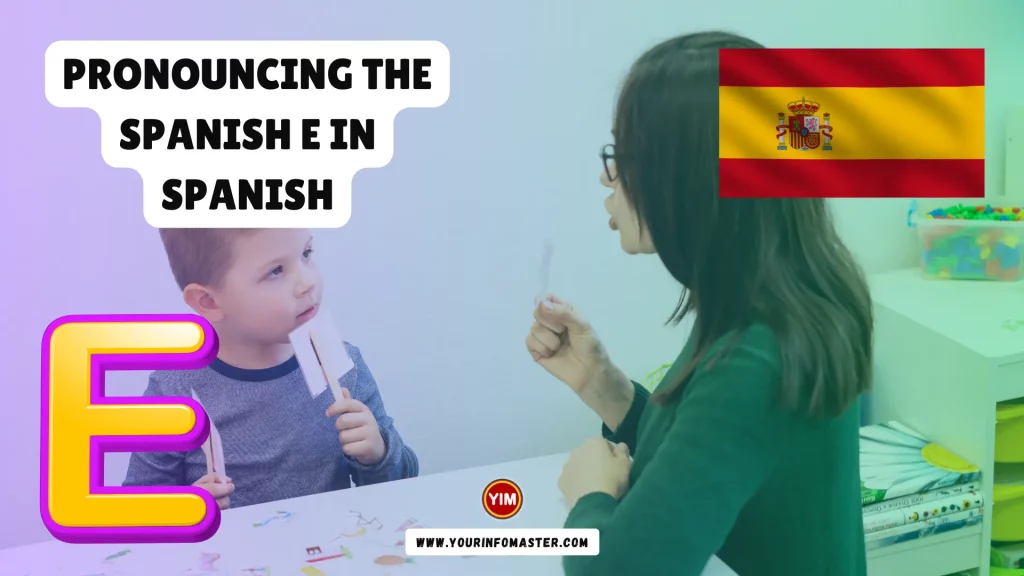Pronouncing the Spanish E in Spanish. When it comes to Spanish pronunciation, the letter “E” might seem straightforward, especially for English speakers who are accustomed to the same letter in their own language.
However, like any aspect of language learning, there are nuances and subtleties to be explored. In this blog post, we’ll dive into the art of pronouncing the Spanish “E” and uncover some essential tips to help you perfect this vowel sound.
Check also: How To Pronounce Vowels in Spanish?
1. The Basics of the Spanish “E”
At first glance, you might think that the Spanish “E” is pronounced just like the English “E” in words like “red” or “bed.” While there is some similarity, the Spanish “E” has a distinct quality that sets it apart.
2. The Pure “E” Sound
In Spanish, the “E” sound is pure and unchanging, meaning that it retains its distinct sound regardless of where it appears in a word or whether it’s stressed or unstressed. Imagine the sound you make when saying “egg” or “let.” This is the foundation of the Spanish “E.”
3. Embrace the Midway “E”
As you delve deeper into mastering the Spanish “E,” you’ll notice that it falls somewhere between the English short “e” (as in “red”) and the long “ee” (as in “see”). This intermediate quality gives it a unique character that’s important to capture.
4. Practice Makes Perfect
To hone your Spanish “E” pronunciation, practice is essential. Listen to native speakers, repeat words containing the “E” sound, and focus on maintaining that pure, intermediate quality. Pay attention to how your mouth and tongue position themselves when forming the sound.
5. Examples of Words with “E”
Here are some common Spanish words that feature the “E” sound:
- “perro” (dog)
- “leche” (milk)
- “verde” (green)
- “bebé” (baby)
- “selva” (jungle)
6. Keep an Ear Out
Listening to native Spanish speakers is a fantastic way to fine-tune your pronunciation. Pay attention to how they pronounce the “E” sound and try to replicate it. Remember, the more you immerse yourself in authentic language usage, the more your own pronunciation will improve.
7. Embrace the Journey
Mastering the nuances of the Spanish “E” sound might take some time, but the journey is part of the adventure of language learning. Embrace the challenge, enjoy the process, and celebrate each step forward you take in your pronunciation journey.
Check also: Spanish Verb Creer Conjugation
Conclusion
With these insights and a dedicated effort, you’ll find yourself confidently and authentically producing the Spanish “E” sound. So, go ahead, practice, and immerse yourself in the beauty of Spanish pronunciation! ¡Buena suerte! (Good luck!)
If you really enjoyed the article about “Pronouncing the Spanish E in Spanish?,” then I would be very grateful if you’d help it spread by emailing it to your friends or sharing it on Twitter, Instagram, or Facebook. Thank you!
Have you read “Pronouncing the Spanish E in Spanish?“ Which of these blogs are you reading, and how is it similar to one of them?
Read More
- Pronouncing the Spanish CH in Spanish
- Common Spanish Pronunciation Mistakes You Should Avoid
- Is the G in ‘Guacamole’ Silent?
- Pronouncing Difficult Spanish Consonant Sounds
- Mastering Stress and Accent Marks in Spanish
- How to Pronounce R in Spanish?
- How to Write Months in Spanish?
- Spanish Cell Phone and Social Media Abbreviations
- How to Type Spanish Accents and Punctuation in Windows?
- How to Type Spanish Accents and Punctuation on a Mac?
- How to Use Hyphens in Spanish?
- What are Spanish Greetings?
- Spanish Strong Vowels and Weak Vowels

